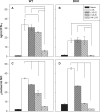Francisella tularensis Vaccines Elicit Concurrent Protective T- and B-Cell Immune Responses in BALB/cByJ Mice
- PMID: 25973794
- PMCID: PMC4431730
- DOI: 10.1371/journal.pone.0126570
Francisella tularensis Vaccines Elicit Concurrent Protective T- and B-Cell Immune Responses in BALB/cByJ Mice
Abstract
In the last decade several new vaccines against Francisella tularensis, which causes tularemia, have been characterized in animal models. Whereas many of these vaccine candidates showed promise, it remains critical to bridge the preclinical studies to human subjects, ideally by taking advantage of correlates of protection. By combining in vitro intramacrophage LVS replication with gene expression data through multivariate analysis, we previously identified and quantified correlative T cell immune responses that discriminate vaccines of different efficacy. Further, using C57BL/6J mice, we demonstrated that the relative levels of gene expression vary according to vaccination route and between cell types from different organs. Here, we extended our studies to the analysis of T cell functions of BALB/cByJ mice to evaluate whether our approach to identify correlates of protection also applies to a Th2 dominant mouse strain. BALB/cByJ mice had higher survival rates than C57BL/6J mice when they were immunized with suboptimal vaccines and challenged. However, splenocytes derived from differentially vaccinated BALB/cByJ mice controlled LVS intramacrophage replication in vitro in a pattern that reflected the hierarchy of protection observed in C57BL/6J mice. In addition, gene expression of selected potential correlates revealed similar patterns in splenocytes of BALB/cByJ and C57BL/6J mice. The different survival patterns were related to B cell functions, not necessarily to specific antibody production, which played an important protective role in BALB/cByJ mice when vaccinated with suboptimal vaccines. Our studies therefore demonstrate the range of mechanisms that operate in the most common mouse strains used for characterization of vaccines against F. tularensis, and illustrate the complexity necessary to define a comprehensive set of correlates.
Conflict of interest statement
Figures





Similar articles
-
Models derived from in vitro analyses of spleen, liver, and lung leukocyte functions predict vaccine efficacy against the Francisella tularensis Live Vaccine Strain (LVS).mBio. 2014 Apr 8;5(2):e00936. doi: 10.1128/mBio.00936-13. mBio. 2014. PMID: 24713322 Free PMC article.
-
Activities of Murine Peripheral Blood Lymphocytes Provide Immune Correlates That Predict Francisella tularensis Vaccine Efficacy.Infect Immun. 2016 Mar 24;84(4):1054-1061. doi: 10.1128/IAI.01348-15. Print 2016 Apr. Infect Immun. 2016. PMID: 26810039 Free PMC article.
-
An In Vitro Co-culture Mouse Model Demonstrates Efficient Vaccine-Mediated Control of Francisella tularensis SCHU S4 and Identifies Nitric Oxide as a Predictor of Efficacy.Front Cell Infect Microbiol. 2016 Nov 25;6:152. doi: 10.3389/fcimb.2016.00152. eCollection 2016. Front Cell Infect Microbiol. 2016. PMID: 27933275 Free PMC article.
-
Progress, challenges, and opportunities in Francisella vaccine development.Expert Rev Vaccines. 2016 Sep;15(9):1183-96. doi: 10.1586/14760584.2016.1170601. Epub 2016 May 3. Expert Rev Vaccines. 2016. PMID: 27010448 Review.
-
Innate and adaptive immune responses to an intracellular bacterium, Francisella tularensis live vaccine strain.Microbes Infect. 2003 Feb;5(2):135-42. doi: 10.1016/s1286-4579(02)00084-9. Microbes Infect. 2003. PMID: 12650771 Review.
Cited by
-
Working correlates of protection predict SchuS4-derived-vaccine candidates with improved efficacy against an intracellular bacterium, Francisella tularensis.NPJ Vaccines. 2022 Aug 17;7(1):95. doi: 10.1038/s41541-022-00506-9. NPJ Vaccines. 2022. PMID: 35977964 Free PMC article.
-
Differential Immune Response Following Intranasal and Intradermal Infection with Francisella tularensis: Implications for Vaccine Development.Microorganisms. 2021 Apr 30;9(5):973. doi: 10.3390/microorganisms9050973. Microorganisms. 2021. PMID: 33946283 Free PMC article. Review.
-
In vivo and in vitro immune responses against Francisella tularensis vaccines are comparable among Fischer 344 rat substrains.Front Microbiol. 2023 Jul 13;14:1224480. doi: 10.3389/fmicb.2023.1224480. eCollection 2023. Front Microbiol. 2023. PMID: 37547680 Free PMC article.
-
Tularemia vaccine development: paralysis or progress?Vaccine (Auckl). 2016;6:9-23. doi: 10.2147/VDT.S85545. Epub 2016 May 4. Vaccine (Auckl). 2016. PMID: 27200274 Free PMC article.
-
Immunoproteomic Analysis of Antibody Response of Rabbit Host Against Heat-Killed Francisella tularensis Live Vaccine Strain.Curr Microbiol. 2017 Apr;74(4):499-507. doi: 10.1007/s00284-017-1217-y. Epub 2017 Feb 23. Curr Microbiol. 2017. PMID: 28233060
References
-
- Dennis DT, Inglesby TV, Henderson DA, Bartlett JG, Ascher MS, Eitzen E, et al. (2001) Tularemia as a biological weapon: medical and public health management. Journal of the American Medical Association 285: 2763–2773. - PubMed
-
- Burke DS (1977) Immunization against tularemia: analysis of the effectiveness of live Francisella tularensis vaccine in prevention of laboratory-acquired tularemia. Journal of Infectious Diseases 135: 55–60. - PubMed
-
- Saslaw S, Eigelsbach HT, Prior JA, Wilson HE, Carhart S (1961) Tularemia vaccine study. II. Respiratory challenge. Archives of Internal Medicine 107: 134–146. - PubMed
-
- Sandstrom G (1994) The tularaemia vaccine. J Chem Technol Biotechnol 59: 315–320. - PubMed
Publication types
MeSH terms
Substances
LinkOut - more resources
Full Text Sources
Other Literature Sources
Molecular Biology Databases

